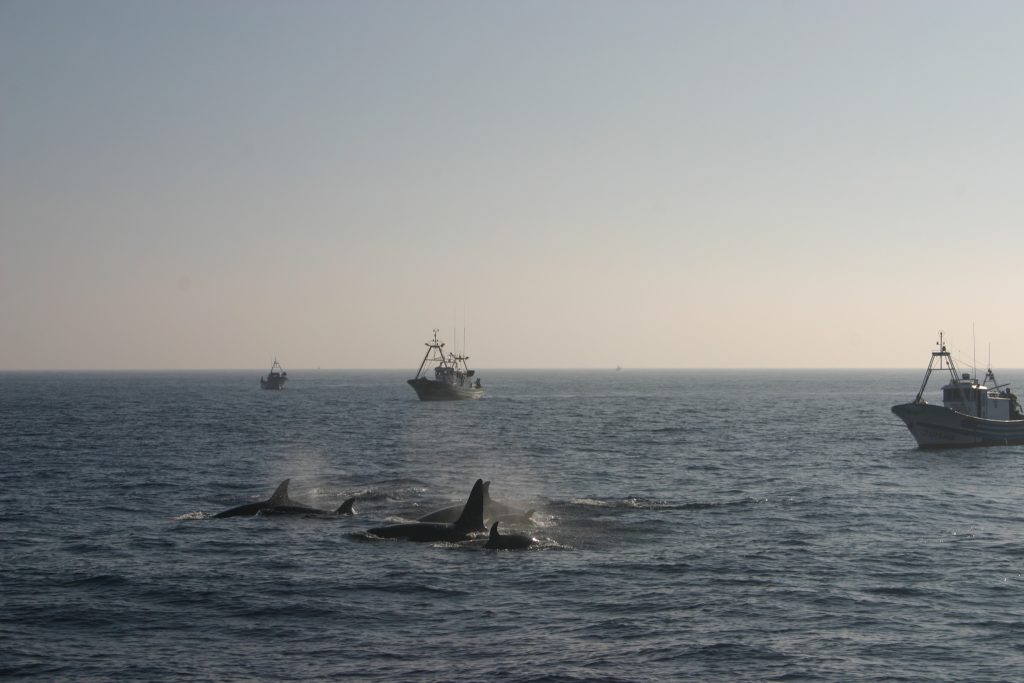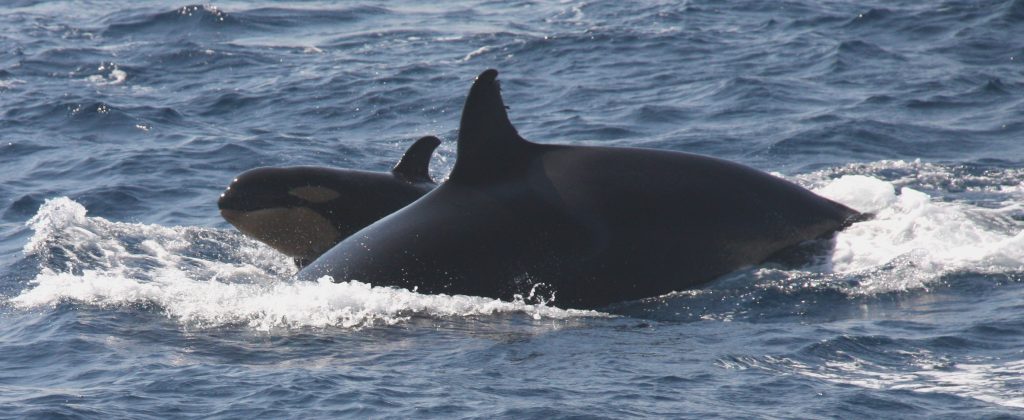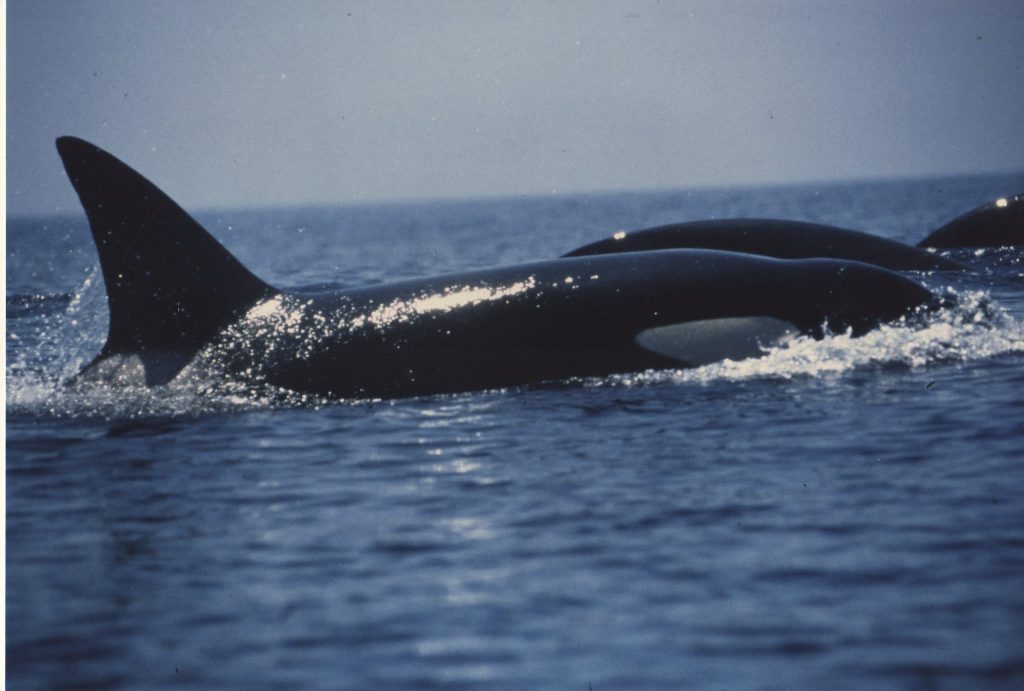One of my favourite stories of the seas is the one on the Orcas that visit the Strait of Gibraltar.
I have encountered Orcas when sailing in the middle of the Atlantic Ocean, in the Galapagos islands or in Norway … but the most impressive interaction of these extraordinary marine mammals in the wild with humans, happens between the columns of Hercules.
During 11 years of my life I have been collaborating, on and off, with firmm® (Foundation for Information and Research on Marine Mammals), founded in 1998 by Katharina Heyer in the little fishermen village of Tarifa. This was the beginning of research on marine mammals in the Strait of Gibraltar, as not data was available on the subject at the time. In those days we were a little group of Oceans Lovers passionate and curious about the story behind the presence of dolphins and whales in the Strait and wanted to know more. Nowadays, firmm became a whale-watch operator and before every whale watch trip, volunteers give the passengers talks about the marine mammals and environmental concerns in several languages. Between 2001 and 2011, we organised educational campaigns with the collaboration of government and corporate funds, which allowed us to reach out to over 20.000 scholars in the region.
The little village of Tarifa is the most Southern point of continental Europe and is situated in the heart of the Strait of Gibraltar, just 14 km away from the African continent. Therefore, the closest point to Africa is the little military island of Tarifa and not “Europa point” in Gibraltar. The little village of Tarifa has a worldwide reputation to be one of the best windsurf destinations, more than for its marine mammals… but they are there! The Strait of Gibraltar is known for drugs and immigrants’ transit but is also one of the areas with the most maritime traffic in the world with nearly 350 ships transiting in- or -out it every day.
The Strait of Gibraltar also emblematic because it is where the Mediterranean Sea and the Atlantic Ocean meet. Every 6 hours, through the tides, the Atlantic pushes into the Mediterranean who does not really have anywhere to go apart from the Suez Canal. Because the evaporation of the water during the summer months, the Mediterranean is warmer and also has a higher salinity then the Atlantic Ocean. For this reason, the Mediterranian is pushed down to the bottom of the seabed with the outgoing current, revolving dead sediments which are brought to the surface … a phenomena is called “upwellings”. Through photosynthesis, plankton will bloom again and start-up the food chain; from phytoplankton, zooplankton, krill, small fish, to all the way up … marine mammals.
In the Strait of Gibraltar, we can encounter 4 species of resident marine mammals, being the common dolphins, the striped dolphins, the bottlenose dolphins and about 600 pilot whales. Because of the small distance between the two continents it is also a good spot to observe larger whales, like sperm whales or fin whales during their migration in- and out- of the Mediterranean.



The Orcinus Orca or “Killer Whale” got this nickname because they are known to eat other marine mammals such as seals, dolphins, or young whales. No humans have ever been killed by Orcas in freedom, and the only known cases of humans being killed by killer whales were by animals in captivity. I invite you to read an article I wrote called “marine mammals in captivity” to be found on my LinkedIn, Facebook, or look it up in “The Islander” magazines’ digital format (May 2020).
Before entering in detail about the Orcas and their interaction with humans we first need to understand the fishing of the largest tuna in the world, which is as main reason behind the reason of the Orcas visiting the Strait of Gibraltar. The Atlantic Blue-fin Tuna (Thunnus thynnus), or in Spanish “Atun Rojo”, is the largest tuna in the world. This fish can weight up to 680 kg and generally swims between 500 and 1000 meters deep. This apex predator lives generally till the age of 15 to 30 years. This pelagic specie does not use their gills for oxygenation like other fish, as they keep their jaw open for which they need to swim in order not to suffocate. This is the main reason why these tunas cannot be bread in “normal” fish-farms, unless you tow the whole of the fish-farm out through the open water with boats. These tunas will migrate from the Atlantic Ocean to the Mediterranean Sea for their spawning activities (fertilisation and releasing of eggs) in order to guarantee their progeniture. 30% of this migration includes tuna that have travelled from the Gulf of Mexico and therefore cross the Atlantic Ocean twice a year. The spawning will happen somewhere between May and August, with its peak between June and July. One of the main spawning areas includes the South of the Balearics islands, which happens around 2-4h.am at a depth of 4 to 5 meters. Important fact to remember is that a tuna of 15 to 20 years old will lay about 45.000.000 eggs, from which only a small percentage will make it to adult age.
Orcas swim max. 50-55 km/h, where these tunas can swim about 70-100km/h. and it is therefore quite difficult for the Orca to catch a Bluefin tuna. We, humans, are of course interested in catching these tunas as well, and we do that since a long time. Proves of tuna fishing in this particular area of the world can be found in the Roman ruins of Baelo Claudia, two centuries B.C. The presence of Orcas also goes back to the time of the Roman, which can be found through the indication of the name “Cabo Espartel” on the maritime chart of this area (on the Moroccan coast). The name “Esparte” is, still today, how Moroccan fishermen call the Orca referring to the dorsal fin (esparte = spade), which for a male 9 meters/ 9 tons individual can be as high as 2 meters.
We need to differentiate two types of tuna fishing arts in this area of the world.
1. Almadrabas, which is a specific type of purse seine fishing, catching tuna before entering the Mediterranean and therefore before the spawning activity takes place.
2. Palangre: a type of long-line fishing, which takes place after the spawning when the tuna swims back to the Atlantic Ocean.
ALMADRABA: Four Almadrabas are laid out from the little fishing villages of Conil, Barbate, Zahara de los Atunes and Tarifa, on the Spanish Atlantic coast just before the entrance to the Mediterranean. You can picture the Almadraba by imagining an underwater fence of over a kilometre long which guides these large tunas swimming along the coast into a labyrinth of nets which ends in a central cage called “El Copo”. Once enough the tunas are caught, fishermen will lift this cage to the surface through block, pulleys, and lines with the help of small boats equipped with pillars. Once the nets are lifted, men will step in there till their chest in the water, equipped with large hooks to drag the tuna alongside their boats to get hoisted. The scenery is bloody and extremely dangerous for the men itself as the fins of tuna are sharp as razorblades. The tunas are caught before they had the opportunity for spawning, with the obvious repercussion and additional pressure on the dramatic drop in population this specie.
PALANGRE: Once the tuna schools head back out of the Mediterranean, they will be hungry as they have not been eating for a little while. The Spanish and Moroccan fishermen know that and will be waiting for them in the middle of the Strait to catch them. The deepest point in the Strait of Gibraltar is about 1000 meters deep, but in some areas, it is only about 300-400 meters deep. The palagre fishermen prepared their long lines, equipped with hooks, using sardines as lures in the harbour. Once at sea, these lines are dropped down to the bottom by throwing the hook attached to a cement block overboard. Once the hook reaches the required depth, they give the line a strong pull to break a thin line between the hook and the stone. The tunas swimming up these underwater hills will encounter the sardines as a well-deserved bite… and the fight is on! You would be surprised to see how, especially the Moroccan fisherman, handle the lifting of a 200-300 kg tuna bare-handed from their little 8-9 meter wooden boat. The Spanish fishing boats are not much bigger but might be equipped with a hydraulic winch to hoist the tunas on board. That is the moment of opportunity the Orcas have been waiting for. When the fishermen have the tuna about 30-40 meters under their boat, the killer whales will steal the tuna from the fisherman. They will bite the belly of the tuna first (la ventresca), which is the fattest part of the tuna. The Orcas have been seen changing their course sometimes as a reaction to the noise of the hydraulic winches being activated. They know exactly when to attack and after the first bite in the belly they will try to steel the whole tuna off the hook of the fishermen. The presence of youngsters within the pods indicate that the opportunity to teach their calves in the process is used. The head of the tuna, where the hook is located, is never part of the attack. They might remember that they should stay away from the head/hook or might use their echolocation to sense the hook. It has always surprised me to see the how acceptant these fishermen are toward the Orcas … I mean, surely there is not a lot they can do to a pod of Orcas from their small boats, but still… Also, over the years, the fishermen got used to the presence of the whale-watch boats and sometimes show-off with the leftovers of the tuna after the attack for the tourist to make pictures.
A total of about 45 Orcas have been monitored in this area which is divided into 5 pods (=families). Two pods will not interact with humans and have only been seen approaching the bay of Cadiz or Barbate. One pod will get closer to the palangre fishermen but will not interact, as maybe they do not know how to do the stealing or might be scared of the interaction. And the remaining two pods are the ones engaging in the interaction of trying to rob the tunas of the fishermen.

Since 1970, the Bluefin Tuna population has decrease by 85-90%. The main reason is the lucrative fishing of this expensive fish. The main client is Japan, where the highest bidder has paid 1.000.000$ for one Bluefin tuna. Around 2003-2004, I remember a fishing vessel of the Japanese fleet being alongside in the port of Tarifa, loading all the tuna coming from the Almadrabas directly onboard in order to process the fish immediately. They had an electronic measurement tools in the shape of a needle that could measure the % of fat available in the fish, and for which some tunas were transported in ice to the airport of Malaga in order to reach the Tokyo fish market asap.
CITES listed the Bluefin tuna as “endangered specie”, and the EU enforced an international ban on tuna fishing in 2010. Strangely enough, the same people who signed that EU agreement, later did not sign the proposal against the international trade of the tuna. Economical remuneration in exchange of lowering the quotes of the tuna fishing is part of the negotiations, but even that was not good news for the little community of these four Almadrabas accounting for about 400 workers. Unfortunately, these political measures to keep lowering these quotes on the long-term seem not to be consistent, most probably due to political pressure and negotiations between the several parties (EU, the ministry of fisheries, the fishermen associations…). As a prove of lack of the continuity and perseverance towards objectives an increase of a 10% on the 2020 quote was permitted, under the name “scientific quote” with as excuse that the bluefin population has recovered strength.


Within this political process, the little palangre fishermen fleet, where somehow left behind. Their quotes were lowered, but they do not really have any saying as the fleet is too small and includes Spanish as Moroccan fishermen. Unfortunately, politics did not realistically evaluate the importance of that small fleet of palangre fishermen. This type of fishing is not only an honest interaction between tuna, orca, and fishermen, but it also feeds the orcas and allows spawning to happen. In addition to that, no economic value has been allocated to the life stock of Orcas. A normal whale-watch trip is worth about 30 euros/pp and an orca trip (between 15 July and 15 August) is sold at 45 euros; multiplied by a minimum of 70.000 tourist doing this activity every season, should have been evaluated. The local community of Tarifa has an economical return and therefore a responsibility towards this unique interaction of palangre fishing art/ Orca/ Eco-tourism.
When, especially in the last years, Orcas have been spotted entering more and more the deeper in the Mediterranean it is not good news, as they most probably are looking for alternatives being hungry.

Eat less or no tuna and help protect our Oceans through sustainable political decision and shifting personal habits. We are all in it together, so personal responsibility = global responsibility!
Greetings,
Capt. Dominique Geysen
Photo credits to firmm®



